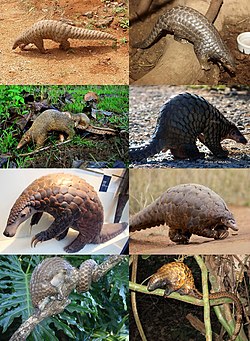センザンコウ科
センザンコウ科(穿山甲、学名: Manidae)は鱗甲目の科。鱗甲目の中で唯一の現生科である。
| センザンコウ科 | |||||||||||||||||||||
|---|---|---|---|---|---|---|---|---|---|---|---|---|---|---|---|---|---|---|---|---|---|
 センザンコウの現生種
| |||||||||||||||||||||
| 保全状況評価[2] | |||||||||||||||||||||
| 全種が ワシントン条約附属書Ⅰ | |||||||||||||||||||||
| 分類 | |||||||||||||||||||||
| |||||||||||||||||||||
| シノニム | |||||||||||||||||||||
|
シノニムリスト:
| |||||||||||||||||||||
| 和名 | |||||||||||||||||||||
| センザンコウ科[4] | |||||||||||||||||||||

|
分類と系統
編集分類の歴史
編集2000年代まで現生のセンザンコウは全てManis属に分類されていたが、その後Manis属、 Phataginus属、Smutsia属の3属に分割された[5][6]。
以下、和名は川田ほか(2018)による[4]。
分類
編集- Family: Manidae センザンコウ科
- Subfamily: Maninae (Gray, 1821)
- Genus: Manis (Linnaeus, 1758)
- (unranked): northern Asian clade
- Manis pentadactyla (Linnaeus, 1758) ミミセンザンコウ
- †Manis hungarica (Kormos, 1934)
- (unranked): southern Asian clade
- Manis crassicaudata (Gray, 1827) インドセンザンコウ
- Manis sp. (Scale_H4 & Scale_H8)[7][8][1]
- †Manis lydekkeri (Dubois, 1908)
- Subgenus: Paramanis (Pocock, 1924)
- Manis javanica (Desmarest, 1822) マレーセンザンコウ
- Manis culionensis (de Elera, 1895) パラワンセンザンコウ
- †Manis palaeojavanica (Dubois, 1907)
- (unranked): northern Asian clade
- Genus: Manis (Linnaeus, 1758)
- (unranked): African clade
- Subfamily: Phatagininae (Gaubert, 2017)
- Genus: Phataginus (Rafinesque, 1821)
- Phataginus tetradactyla (Linnaeus, 1766) オナガセンザンコウ
- Phataginus tricuspis(Rafinesque, 1821) キノボリセンザンコウ
- Genus: Phataginus (Rafinesque, 1821)
- Subfamily: Smutsiinae (Gray, 1873)
- Genus: Smutsia (Gray, 1865)
- Smutsia gigantea(Illiger, 1815) オオセンザンコウ
- Smutsia temmincki(Smuts, 1832) サバンナセンザンコウ
- †Smutsia olteniensis (Terhune, 2021)[9]
- Genus: Smutsia (Gray, 1865)
- Subfamily: Phatagininae (Gaubert, 2017)
- Incertae sedis
- †Manidae sp. [DPC 3972 & DPC 4364] (Gebo & Rasmussen, 1985)
- Subfamily: Maninae (Gray, 1821)
系統
編集鱗甲目内におけるセンザンコウ科の系統的位置[5][6][10][11][12][1]。
| Pholidotamorpha |
| |||||||||||||||||||||||||||||||||||||||||||||||||||||||||||||||||||||||||||||||||||||||||||||||||||||||||||||||||||||
| (Pholidota sensu lato) |
脚注
編集- ^ a b c Sean P. Heighton, Rémi Allio, Jérôme Murienne, Jordi Salmona, Hao Meng, Céline Scornavacca, Armanda D. S. Bastos, Flobert Njiokou, Darren W. Pietersen, Marie-Ka Tilak, Shu-Jin Luo, Frédéric Delsuc, Philippe Gaubert (2023.) "Pangolin genomes offer key insights and resources for the world’s most trafficked wild mammals"
- ^ I, II and III (valid from 22 June 2021)<https://cites.org/eng> [Accessed 7/9/2023]
- ^ J. E. Gray. (1825.) "An outline of an attempt at the disposition of Mammalia into Tribes and Families, with a list of genera apparently appertaining to each Tribe." Annals of Philosophy, new series 10:337-344
- ^ a b 川田伸一郎, 岩佐真宏, 福井大, 新宅勇太, 天野雅男, 下稲葉さやか, 樽創, 姉崎智子, 横畑泰志 「世界哺乳類標準和名目録」『哺乳類科学』58巻 別冊、日本哺乳類学会、2018年、1 - 53頁。
- ^ a b Gaudin, Timothy (2009). “The Phylogeny of Living and Extinct Pangolins (Mammalia, Pholidota) and Associated Taxa: A Morphology Based Analysis”. Journal of Mammalian Evolution (Heidelberg, Germany: Springer Science+Business Media) 16 (4): 235–305. doi:10.1007/s10914-009-9119-9.
- ^ a b Kondrashov, Peter; Agadjanian, Alexandre K. (2012). “A nearly complete skeleton of Ernanodon (Mammalia, Palaeanodonta) from Mongolia: morphofunctional analysis”. Journal of Vertebrate Paleontology 32 (5): 983–1001. doi:10.1080/02724634.2012.694319. ISSN 0272-4634.
- ^ Huarong Zhang, Mark P. Miller, Feng Yang, Hon Ki Chan, Philippe Gaubert, Gary Ades, Gunter A. Fischer (2015.) "Molecular tracing of confiscated pangolin scales for conservation and illegal trade monitoring in Southeast Asia", Global Ecology and Conservation, Volume 4, Pages 414-422
- ^ Jingyang Hu, Christian Roos, Xue Lv, Weimin Kuang, Li Yu (2020.) "Molecular Genetics Supports a Potential Fifth Asian Pangolin Species (Mammalia, Pholidota, Manis)" Zoological Science, 37(6):538-543
- ^ Terhune, C. E.; Gaudin, T.; Curran, S.; Petculescu, A. (2021). “The youngest pangolin (Mammalia, Pholidota) from Europe”. Journal of Vertebrate Paleontology 41 (4): e1990075. doi:10.1080/02724634.2021.1990075.
- ^ Du Toit, Z.; Grobler, J. P.; Kotzé, A.; Jansen, R.; Brettschneider, H.; Dalton, D. L. (2014). “The complete mitochondrial genome of Temminck's ground pangolin (Smutsia temminckii; Smuts, 1832) and phylogenetic position of the Pholidota (Weber, 1904)”. Gene 551 (1): 49–54. doi:10.1016/j.gene.2014.08.040. PMID 25158133.
- ^ du Toit, Z.; du Plessis, M.; Dalton, D. L.; Jansen, R.; Paul Grobler, J.; Kotzé, A. (2017). “Mitochondrial genomes of African pangolins and insights into evolutionary patterns and phylogeny of the family Manidae”. BMC Genomics 18 (1): 746. doi:10.1186/s12864-017-4140-5. PMC 5609056. PMID 28934931.
- ^ Philippe Gaubert, Agostinho Antunes, Hao Meng, Lin Miao, Stéphane Peigné, Fabienne Justy, Flobert Njiokou, Sylvain Dufour, Emmanuel Danquah, Jayanthi Alahakoon, Erik Verheyen, William T Stanley, Stephen J O’Brien, Warren E Johnson, Shu-Jin Luo (2018) "The Complete Phylogeny of Pangolins: Scaling Up Resources for the Molecular Tracing of the Most Trafficked Mammals on Earth" Journal of Heredity, Volume 109, Issue 4, Pages 347–359
外部リンク
編集- ZSL Pangolin Conservation
- Pangolin: Wildlife summary from the African Wildlife Foundation
- Tree of Life of Pholidota
- National Geographic video of a pangolin
- Proceedings of the Workshop on Trade and Conservation of Pangolins Native to South and Southeast Asia (PDF)
- The Phylogeny of Living and Extinct Pangolins (Mammalia, Pholidota) and Associated Taxa: A Morphology Based Analysis (PDF)
- Bromley, Victoria (Director/Producer), Young, Nora (Narrator/Host), Diekmann, Maria (2018). Nature: The World's Most Wanted Animal. United States: PBS.
- Coronavirus: Revenge of the Pangolins? The New York Times, March 6, 2020.